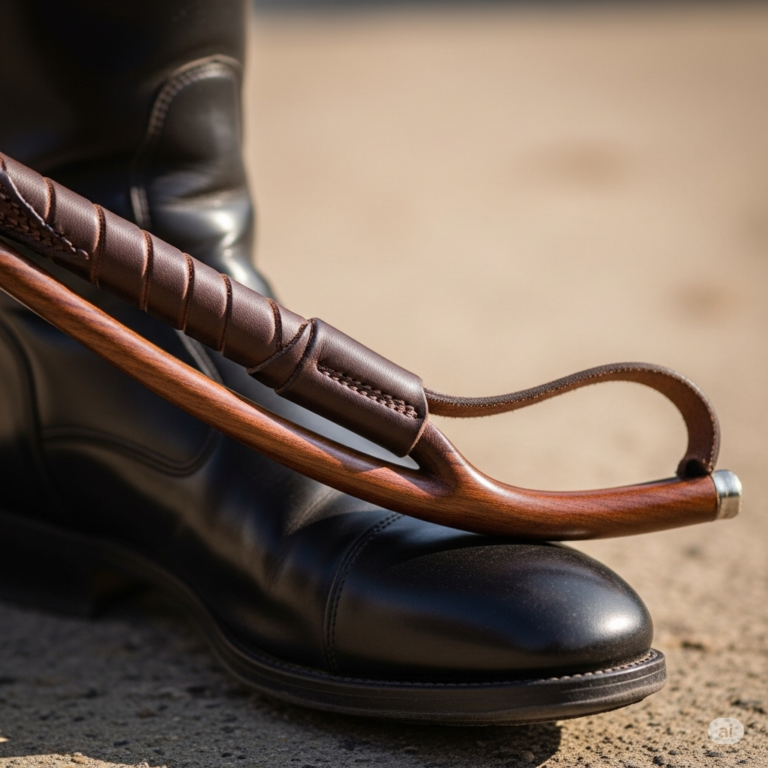Introduction
The riding crop is a small but significant tool in the equestrian world. Used for centuries, it represents both tradition and technique. Often misunderstood, the riding crop is more than just an accessory—it is a method of communication between rider and horse. This article explores the full story of the riding crop, from its historical origins to its modern-day applications and ethical concerns.
What Is a Riding Crop?
A riding crop is a short type of whip designed to aid a rider in directing and encouraging a horse. Unlike traditional whips, it is shorter and has a wide, flat end known as the keeper. This flat tip allows the rider to make gentle contact with the horse without causing harm. Riding crops are commonly used in show jumping, dressage, and general horseback riding for both training and competition.
Historical Background
The use of sticks or light whips for riding dates back thousands of years. Ancient civilizations like the Romans, Egyptians, and Persians used tools similar to modern-day crops to guide animals. However, the modern riding crop originated in Europe during the Middle Ages, when horse riding became a central part of military life and aristocratic culture.
During this period, crops were made using natural materials like wood, leather, and bone. Nobles often decorated their riding equipment, including crops, to show off wealth and status. Over time, as horse riding became a leisure activity and sport, the riding crop evolved into a practical, lightweight tool for refined communication between horse and rider.
Structure and Design
A typical riding crop consists of three parts:
-
Handle – The part held by the rider. It is often wrapped with leather or rubber for a secure grip. Some handles may include a wrist loop.
-
Shaft – The flexible middle section, made from materials such as fiberglass or cane and covered in fabric or leather.
-
Keeper (or Popper) – The short, wide piece at the end used for tapping the horse. It creates sound and mild pressure without inflicting pain.
The total length usually ranges between 24 to 30 inches. It is short enough to allow precision but long enough to be effective.
Purpose of a Riding Crop
Contrary to popular belief, riding crops are not used for punishment. Instead, they serve several important purposes:
-
Encouragement: A light tap can motivate the horse to move forward or increase pace.
-
Reinforcement: It reinforces leg or voice commands if the horse is slow to respond.
-
Correction: It helps correct specific behaviors, like stopping or turning in the wrong direction.
-
Precision: In competitive sports, the crop provides extra guidance to fine-tune the horse’s actions.
A well-trained rider uses the crop sparingly and skillfully, never relying on it as the primary tool for control.
Types of Crops and Related Tools
There are different types of riding crops and related tools, each with its own specific use:
-
Standard Riding Crop: Used for everyday riding and basic training.
-
Jump Bat: A short crop with a wide keeper, used in show jumping for quick and controlled reinforcement.
-
Dressage Whip: Longer than a crop, used for more subtle signals in dressage.
-
Hunting Crop: Features a hook or thong and is used in fox hunting for opening gates or clearing paths.
Choosing the right tool depends on the rider’s discipline, the horse’s training level, and the situation.
Riding Crop in Equestrian Sports
In equestrian competitions, crops are allowed under specific regulations. Riders use them to maintain control and precision during high-speed or high-difficulty maneuvers. Sports like show jumping, eventing, and polo often require a crop as part of the standard gear.
However, misuse is strictly monitored. Most competitions follow guidelines that limit:
-
The intensity and purpose of its use.
Violating these rules can result in penalties or disqualification, emphasizing the importance of responsible handling.
Symbolism and Culture
The riding crop has long been associated with power, authority, and elegance. In historical paintings and literature, noblemen and women are often depicted holding a crop as a sign of control and class.
In popular culture, the crop has taken on symbolic meanings beyond the equestrian world. It has appeared in fashion, film, and even performance art, often representing strength or dominance. Despite these alternative interpretations, its primary identity remains firmly rooted in horse riding.
Modern Debates and Ethical Concerns
With increasing awareness about animal rights, the riding crop has faced ethical scrutiny. Some believe its use—especially in competitive settings—may cause unnecessary stress or pain to horses.
In response, various organizations, including the British Horse Society (BHS) and Fédération Équestre Internationale (FEI), have implemented strict guidelines to promote humane treatment. These include:
-
Banning excessive use of the crop.
-
Discouraging its use on sensitive areas like the face or flanks.
-
Encouraging positive reinforcement techniques over physical aids.
Modern riders are also educated in gentle training methods that prioritize the well-being of the horse. In many cases, the crop is used less frequently or as a backup aid when other cues are ineffective.
Training with Compassion
Proper training in crop use emphasizes:
-
Timing: A quick, light tap should be given immediately after the horse fails to respond to another aid.
-
Consistency: The message must be clear and consistent so the horse understands the purpose.
-
Moderation: The crop is never used out of frustration or anger.
When used ethically, the crop can enhance communication and build a stronger bond between rider and horse.
Conclusion
The riding crop may be small, but its story is vast and meaningful. From its medieval roots to its role in modern sports, the riding crop has evolved alongside our understanding of horses and humane training. While controversies around its use persist, responsible handling and proper education have helped reshape its role as a respectful and effective tool in equestrianism.

